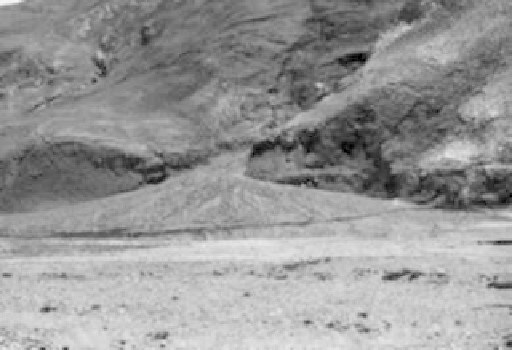Environmental Engineering Reference
In-Depth Information
material is available than can be readily evacuated, depositional features like alluvial fans
form at the base of the mountain. Bedrock surfaces can be exhumed, and channels incised,
into the piedmont if more material is transported away than is delivered from the upslope
source regions. This balance between degree and pattern of erosion of the hillslopes,
and amount and form of sedimentation in the piedmont, is controlled by several factors
including tectonic uplift, as illustrated by the formation of Basin and Range mountains;
change in base level of adjacent river systems, as shown by the integration of river systems
following the opening of the Gulf of California; lithology and structure of the eroding
mountains; morphology of the mountain front, particularly the presence of embayments;
and changes in climate, such as from cool and wet to warm and dry conditions.
Major landforms in the piedmont are
alluvial fans
and
pediments
. Alluvial fans—so-
called because of their characteristic fan shape in plan view—are the depositional sites
for sediments carried in mountain streams and washes and frequently originate from a
specific point along the mountain front. In general, coarser sediments are deposited near
the mountain base, with finer sediments deposited further out on the fan surface. Excellent
examples of alluvial fans can be seen in Death Valley National Park of California's Mojave
Desert (Figure 2.6). Several alluvial fans can coalesce along the mountain front to form a
continuous zone of sediments called a
bajada
.
Desert pavements
are flat surfaces formed of interlocked gravels, typically found on
alluvial fans, which can be tens to hundreds of thousands of years old. They are thought
to be formed by eolian deposition on the surface and a combination of vertical motion of
sedimentary particles and removal of small particles by wind and water.
11-13
This land-
form is important as it forms a protective armor for the underlying sediments and soils
and reduces erosion. Frequently the gravel forming desert pavements is a deep brown to
black color regardless of the actual colors of the rocks comprising the gravel (Figure 2.7).
A coating of
desert varnish
on the gravel causes this dark coloration. Desert varnish is
composed of iron- and manganese-bearing clay minerals and is thought to form by
the deposition of iron-bearing clay minerals in dust onto individual gravel surfaces.
Microbial activity also builds varnish coatings by fixing manganese into clay mineral
structures. Desert varnish is not limited to desert pavements—it can develop on any
FIGURE 2.6
Alluvial fans are found at the outlets of large washes on mountain ranges, such as this example from Death
Valley, California. (Courtesy of W.L. Stefanov.)


Search WWH ::

Custom Search